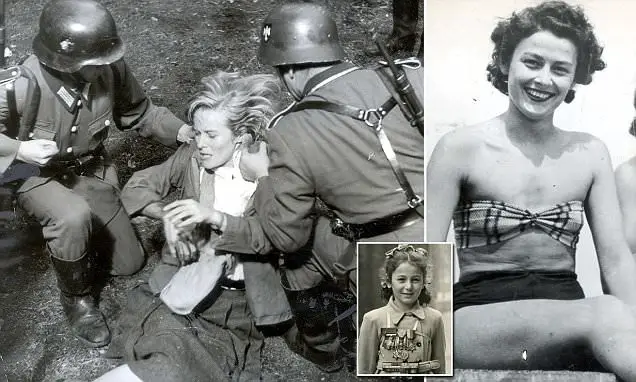Violette Szabo: The Young Heroine of World War II
Violette Szabo was a young woman who was willing to risk her life to help others during World War II. Violette Szabo was just 22 years old when she was parachuted into France in 1944 as part of the British Special Operations Executive (SOE). Her mission was to aid French resistance fighters in sabotaging German operations. Despite her young age and lack of combat experience, Violette proved to be a brave and resourceful fighter, who was willing to risk everything to help others.
Early Life and Military Training
Violette Reine Elizabeth Bushell was born on June 26, 1921, in Paris, France. Her mother was a French dressmaker, and her father was an English taxi driver. When Violette was six years old, her father died in a car accident, leaving her mother to raise her and her younger brother alone.
In 1933, Violette and her family moved to London, where she attended school and trained as a shop assistant. When World War II broke out in 1939, Violette joined the Auxiliary Territorial Service (ATS), the women’s branch of the British Army. There, she learned how to drive and repair vehicles.

On June 8, two days after D-Day, Violette was dropped back into France to help co-ordinate Resistance networks around the south-western city of Limoges.
In 1942, Violette applied to join the Special Operations Executive (SOE), which was responsible for organizing and supporting resistance movements in occupied Europe. She passed the rigorous selection process and underwent intense training in espionage, sabotage, and combat. She excelled in physical fitness, marksmanship, and other skills.
Her Mission in France
In April 1944, Violette was parachuted into France along with another SOE agent, Captain Philippe Liewer. Their mission was to support the French Resistance in the area around Limoges in central France.
Violette quickly established contact with local resistance fighters and began organizing acts of sabotage against the German occupiers. She was also responsible for transmitting important intelligence back to SOE headquarters in London.

Unbeknown to Violette, her name had been put forward as a possible recruit by SOE operative George Clement, a French-speaking acquaintance she had met a few times at London dancehalls.
Her Capture and Imprisonment
On June 10, 1944, Violette was traveling in a car with two resistance fighters when they were stopped by a German roadblock near the village of Salon-la-Tour. Violette was captured and taken to the Gestapo headquarters in Limoges, where she was interrogated and tortured. Despite the abuse, Violette refused to betray her comrades or reveal any sensitive information.
Violette was then transferred to Ravens Bruck concentration camp in Germany, where she spent the last few months of her life. She was executed by firing squad on February 5, 1945, at the young age of 23.
Her Legacy
Violette’s bravery and sacrifice have been widely celebrated since the end of the war. She was posthumously awarded the George Cross, the highest civilian honor in the UK, for her heroism. She is also the subject of numerous books, films, and other works of art.
One of the most famous tributes to Violette is the 1958 film “Carve Her Name with Pride,” which stars Virginia McKenna as Violette. The film was based on the book of the same name by R. J. Minney, which was written with the help of Violette’s husband, Etienne Szabo.

Only 22 when she first parachuted into France, Violette was a striking beauty who had previously worked on the perfume counter at a London department store.
Violette’s daughter, Tania Szabo, wrote a book about her mother’s life and legacy, called “Young, Brave, and Beautiful.” The book includes excerpts from Violette’s letters and diaries and provides a personal and moving account of her mother’s courage and sacrifice.

Tania Szabo, the daughter of French-born British World War II agent Violette Szabo, holds her mother’s George Cross medal in July 2015.
Honoring Violette Szabo’s Memory
Violette Szabo’s story is a powerful reminder of the bravery and sacrifice of those who fought against the tyranny of Nazi Germany. Despite her youth, Violette was willing to risk everything to help others and make a difference in the world. Her story is an inspiration to people of all ages and backgrounds, and her legacy continues to live on to this day.
Violette’s bravery and selflessness in the face of danger serve as a role model for people everywhere. Her unwavering determination to fight against the oppression of the Nazi regime and her refusal to betray her comrades in the face of extreme torture has inspired many people around the world.
As we look back on Violette’s life and legacy, it is important to remember that her story is just one of many from the countless individuals who fought against the horrors of World War II. Like Violette, these brave men and women put themselves in harm’s way to fight for a better world and a brighter future.
In conclusion, Violette Szabo’s story is an example of the immense courage and bravery that individuals can show in times of war and conflict. Her legacy will continue to inspire and motivate people for generations, reminding us of the power of human determination and the importance of standing up for what is right, even in the face of danger.

She was executed on my birthday. I will never forget her.